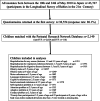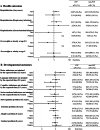In vitro fertilization and long-term child health and development: nationwide birth cohort study in Japan
- PMID: 39557744
- PMCID: PMC11573831
- DOI: 10.1007/s00431-024-05883-y
In vitro fertilization and long-term child health and development: nationwide birth cohort study in Japan
Abstract
The aim of this study is to compare long-term health outcomes between IVF-conceived children and non-IVF-conceived children in Japan, in the context of strong recommendation for single embryo transfer. Using data from a nationwide birth cohort linked with perinatal database, this study analyzed 2140 children born in Japan in May 2010. It compared child health and development outcomes up to 9 years of age between IVF-conceived and non-IVF-conceived children (binary exposure). A Poisson regression with robust variance to estimate the risk ratios for the association between IVF and various long-term child health and developmental outcomes. After adjusting for confounding factors, no significant differences were observed between IVF-conceived and naturally conceived children for most outcomes, including hospitalization, obesity, and developmental milestones. IVF-conceived children showed a slightly lower risk of attention problems at 8 years (adjusted Risk Ratio [aRR]: 0.73, 95% CI: 0.53-1.00). In subgroup analyses, IVF-conceived term children and singletons demonstrated reduced risk of cognitive delays at 5.5 years (aRR: 0.31, 95% CI: 0.10-0.96 and aRR: 0.37, 95% CI: 0.14-0.98, respectively).Conclusion: In this Japanese cohort, IVF conception was not associated with adverse long-term health or developmental outcomes. These findings provide reassurance about the safety of IVF, particularly in the context of single embryo transfer policies. Further research is needed to explore specific IVF protocols and subgroups.
Keywords: Assisted reproductive technology (ART); Development; In vitro fertilization (IVF); Long-term outcome.
© 2024. The Author(s).
Conflict of interest statement
Figures



References
-
- Kupka MS, Chambers GM, Dyer S et al (2024) International Committee for Monitoring Assisted Reproductive Technology world report: assisted reproductive technology, 2015 and 2016. Fertil Steril. 10.1016/J.FERTNSTERT.2024.07.009 - PubMed
-
- Helmerhorst FM, Perquin DAM, Donker D, Keirse MJNC (2004) Perinatal outcome of singletons and twins after assisted conception: a systematic review of controlled studies. BMJ 328:261–264. 10.1136/BMJ.37957.560278.EE - PMC - PubMed
-
- Hart R, Norman RJ (2013) The longer-term health outcomes for children born as a result of IVF treatment: Part I-General health outcomes. Hum Reprod Update 19:232–243. 10.1093/HUMUPD/DMS062 - PubMed
-
- Ceelen M, Van Weissenbruch MM, Roos JC et al (2007) Body composition in children and adolescents born after in vitro fertilization or spontaneous conception. J Clin Endocrinol Metab 92:3417–3423. 10.1210/JC.2006-2896 - PubMed
-
- Guo XY, Liu XM, Jin L et al (2017) Cardiovascular and metabolic profiles of offspring conceived by assisted reproductive technologies: a systematic review and meta-analysis. Fertil Steril 107:622-631.e5. 10.1016/J.FERTNSTERT.2016.12.007 - PubMed
MeSH terms
Grants and funding
LinkOut - more resources
Full Text Sources
Medical

